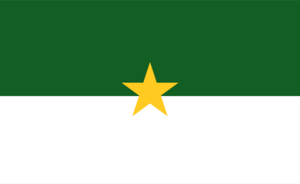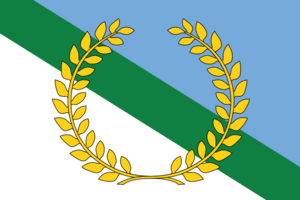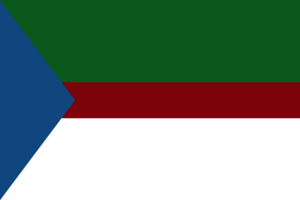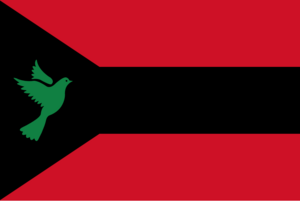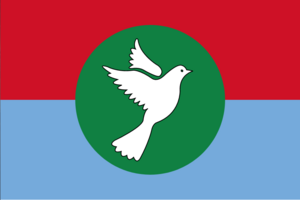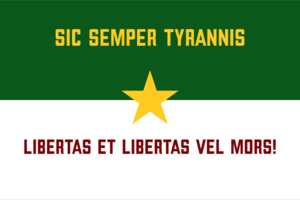Gaia
Gaia, the sole planetary body within the Galilei system, is one of the only earth-like planets known to humanity. Gaia was historically an agricultural powerhouse, supplying upwards of a quarter of humanity's agricultural products before 2292.
Geography
Gaia is about one-tenth smaller than Earth, and its nitrogen-oxygen atmosphere is slightly thicker. This makes Gaia marginally warmer and more favorable to farming during all seasons.
Geographically, the planet has no oceans; however, several areas of the planet possess large 'shot lakes', large groupings of smaller lakes, often interconnected by streams and rivers. The notable exception is Lake Cabot, a large round lake situated on the planet's equator.
Vast rolling plains predominantly cover Gaia as a whole – however, situated several hundred kilometers west of Lake Cabot are the Napoleon Mountains. Running northwest before curving south after several thousand kilometers, the mountain range geographically separates the shot lakes from Lake Cabot.
Gaia does not possess ice caps like earth, with colder regions relegated to the Napoleon Mountains and the Tobruk Desert, a moderately-sized desert situated east of the north end of the Napoleon Mountains.
The planet possesses relatively earth-like seasons; however, nowhere on the planet other than the previously mentioned mountains and desert is known to fall below freezing.
Scarred from several years of war and two orbital landings, some areas of the planet have lost their former ability to support heavy agriculture, with fears that the Tobruk Desert may begin expanding in coming years.
History
In 2129, the first sleeper ships were launched towards the Galilei System, with the first sleeper vessels arriving in the Galilei System in 2133, landing at the sites of the modern metropolises of the planet; these settlements were largely independent until 2150 when the planet's population had reached a sufficient population to form a planetary government in New Venice.
Contact with Sol was finally re-established in 2170, with the construction of a Gateway beginning in 2173 and finishing in 2175, beginning a steady stream of immigration. When the Ares war went hot in 2202, Gaia declared itself neutral, ensuring agricultural exports would continue across human space. The end of the conflict in 2230 brought complete Independence, with Gaia not being invited to the founding of the SCG, sowing the seeds of bitterness towards Sol.
The 2270s brought the planet into an era of significant political uncertainty, with pressure from both the SCG and GCC causing almost constant elections between 2271 and 2290, ending when the Gaian Planetary Parliament dissolved itself for the duration of the Gaian Conflict following the GCC landings, declaring that the Gaian Parliament would be recalled for planet-wide elections by the Mayor of New Venice at 'The soonest reasonable time.' This has been interpreted by successive Mayors of the International City as not before the planet is reunified, kicking the proverbial can down the road for now.
The Gaian Resistance
The Gaian Resistance, despite its name, did not contain many Gaians; Consisting of the remnants of Colonel Montgomery’s forces, reinforced by survivors of the Fourth’s slaughter in Gaian orbit, the Solar forces liquidated their fixed assets and dispersed into the Gaian countryside.
Tactics of the Montgomery resistance to protect their assets involved camouflaging assets hidden in one of the planet’s many forests, fleeing to the relative safety of the Napoleon mountains, or entrenching temporary facilities in the basements or other sub-surface spaces of family farms, ranches, and other social and economic hotspots. This dissuaded the Confederation Navy from using overwhelming orbital strikes against known resistance operations but demonstrably resulted in Gaian casualties throughout the war, both through accidental casualties during raids and from charges against the civilian population of aiding and abetting insurgents.
This had the opposite effect on the Gaian populace in that it was not an uncommon occurrence for Gaian farming families to fire a shot at resistance members to dissuade them from using their farms, as well as civilians quickly reporting resistance members to save themselves and their families from any collateral damage turning a blind eye might have brought.
Modern Division
Gaian Administrative Area
Still, under a military Administration over a decade after the conflict, Southern Gaia holds no representation in the Solar Assembly and is run on the planetary level by an administrative council appointed from the ranks of the Fourth Fleet and Army Group Cabot. They treat Gaia more like an occupied state than a member of the SCG. This continues to contribute to the political situation in the South, where politics are conducted at the municipal level, with pro-autonomy parties regularly in office.
Protectorate of Gaia
While the Northern Hemisphere holds no representation in the Confederation's Directory, an elected parliament runs the Protectorate, answering to a Governor General appointed by the Directory with the directive to continue the flow of agricultural goods to the Confederation. With Gaian exports comprising almost 25% of the GCC's imported food supply, the live and let live philosophy with many in the GCC allows life in the North to go on with little to no interference from Terra.
The Political Tinderbox
Gaia, in the grand scheme of things, is in a stable situation; the planet as a whole is not in a position to change sides or suddenly erupt as an independent state without a sudden rallying factor. While Gaians might protest in the streets of Syracuse or New Madrid against different governments, the one unifying factor for any Gaian who survived the conflict is an absolute anti-war stance. Thus, modern Gaia is a selective tinderbox, waiting for the right order of events to go up in a fireball.
Notable Areas
New Madrid
New Madrid is the Administrative Capital of the North and the second most significant metropolis on the planet, situated amongst the ‘great shot lakes’; the New Madrid Prefecture encompasses the city of New Madrid as its many suburbs wrap around the lakes. New Madrid recently took control of the former Confederation Naval Yards, built by the ICCGN during the conflict as a resupply base; today, it is the largest public transit hub on the planet and often the first stop for travelers heading further into the GCC.
New Madrid is regarded by many in the SCG as one of the only tourist destinations within the GCC, with the city containing a vibrant entertainment district, with countless casinos and resorts on its many lakes.
New Venice
New Venice, the largest city on the planet and officially the capital of Gaia, is, in practice, the only remnant of any semblance of independence on the planet; established as an international city with the Treaty of New Venice, the mayor is regularly involved in mediation between the SCG and GCC.
Set on the southern shore of Lake Cabot, the City houses many governmental offices for both the North and South, as well as the SCG and GCC, resulting in the unique occurrence where members of the two rival superpowers' governments live and work in somewhat close quarters.
The New Venice Constabulary is the only armed force permitted within the city and DMZ as a whole, with all others, including Gaian civilians, forced to relinquish their weapons for the duration of their stay.
Syracuse
Syracuse, renamed from New Syracuse in 2271, is the South’s Largest city and its Administrative Capital, a manufacturing city before the Conflict; Syracuse has seen a boost in the industry since the division of the planet, with Sol encouraging a shift from agriculture to manufacturing. Syracuse houses many of the planet’s workshops for agricultural equipment, exported both to the North and off of the planet; it is quickly becoming one of the largest agricultural equipment exporters in human space.
Situated on the Catalonian River, the city offers less in the way of nightlife than its Northern brother; instead, the lights of cargo vessels are often the only thing illuminating the vast river during the night.
The Strip
The Strip is the name of the 300-kilometer-wide DMZ that spans the planet’s equator, given by the Gaian populace. Not even a speedbump in the event of a conflict, the Strip is run by the government in New Venice with little oversight from either government in the North or South. Many who still reside in the strip are some of the more bitter Gaians, refusing to bend the knee to Sol or the GCC; they are left to their own devices by the New Venice Constabulary, who are more concerned with enforcing the law in the capital.
Flags
- Most Gaians are tri-lingual, speaking the planet's Native Iberian, Zurich Common, and Pan-Slavic.
- The South has a larger population and economy, but is less stable than the North due to unrest.
| Polity | Flag | Description |
|---|---|---|
| Pre-Conflict, New Venice, The Strip | Still extremely popular among the populace, this flag is commonly flown across the planet, with most still considering this flag the ‘correct’ Gaian flag. | |
| Gaian Administrative Area | Rarely seen outside of government property, this flag is only seen in the hands of the general public when it’s being burned during protests against the ongoing military occupation. | |
| Protectorate of Gaia | Similarly to its Southern brother, this flag suffers from the same lack of popularity as the South’s; however, it is popular among Independent immigrants, and is backed by a civilian government. | |
| New Madrid Prefecture | The addition of the dove in 2299 to this flag was considered controversial at the time. However, many have warmed to this flag over the years, being a common sight alongside Pre-conflict flags in the New Madrid Prefecture, or flown by fans at sports events. | |
| Syracuse Prefecture | Once again, a flag that has grown more popular over time, it’s common to see this flag flying across Syracuse and at sports events. | |
| Gaian ‘Rebel’ Flag | While variations of the ‘Rebel’ flag exist, its most common form is a pre-conflict banner with defiant text sown on; these flags are commonly flown during protests or as a replacement for the standard pre-conflict flag by more outspoken Gaians. |
